NVIDIA's Latest Drivers: The 90 Series Control Center
by Josh Venning on June 9, 2006 8:50 AM EST- Posted in
- GPUs
Display
Under the display menu, we see a section for appearance, and multiple displays.
Display Optimization Wizard
This item offers a wizard to help you optimize your display. The following nine screenshots show the steps of the wizard, though the flat panel display calibration step is skipped for non-flat panel displays. (We would recommend choosing flat panel regardless, if you want to use the test pattern to try and align the image on a CRT display.)
First you get the introduction, followed by your display(s). If you choose one of the displays as being a flat panel, you get an extra two screens for flat panel optimization. Next is a screen for color temperature. We found this screen to be a little confusing, but basically what it's saying is that you should use the controls of your display to set the temperature to what you find appropriate. That's not particularly helpful, and the text could be better at explaining what you're supposed to do. Telling you to "set the color temperature to the value that most accurately represents white" when the majority of the screen is black is also less than useful.
After another helpful preparation screen, you get to optimize the brightness and gamma levels of your display. It should be noted that 100% contrast setting is not always ideal on every display. The gamma correction page is also a bit confusing, as the boxes don't actually slide left/right; instead, you click and drag and the color bars change while your mouse cursor moves and the white box remains in the center of the display. The end result of the display optimization wizard is that some people will get slightly better colors for their display, but it's not the same as professional color calibration tools. Still, it's better than nothing.
Move CRT Screen Position
Change Resolution Attributes
Here we see a simple menu to change screen resolution and color quality, as well as the refresh rate.
Adjust Desktop Color Settings
This section gives you control over several color settings to fine tune your display image.
Rotate Display
Change Display Configuration
This section is a straightforward menu that allows you to configure your display configuration if you use multiple displays. Similar functionality is present in the standard Windows Display dialog, so this is basically redundant.
Manage Custom Timings
Having become accustomed to the custom resolution options with the previous control panel, the new version doesn't seem to have all of the same features. For example, in the old NVIDIA interface, there was an easy-to-use dialog that allowed customization of HDTV output signals, including a section for overscan correction, a.k.a. underscan. That appears to be completely missing from the new control panel, though this may be more a case of their Beta nature than a conscious decision on NVIDIA's part. Here are some images showing the new interface as well as the missing overscan correction UI.
What's worse is that the custom resolutions simply don't seem to work properly with the new UI. You can see the first screen which used the new UI to create a custom resolution of 1176x664. Everything seems to be in order, but then why is the screenshot still 1280x720? Try as we might, we could not get the customized 720p underscan resolution to work with the new UI. Switching back to the old interface remedies the problem in short order. (The black border on the last image represents the area on a Toshiba 46H84 HDTV that isn't visible, in case you were wondering.)
Video and Television Settings
The third menu selection only has one option available in it, adjust video color settings. This basically offers the same color settings that we saw for the display color settings, only for video content. Video overlay mode takes a different route through the drivers, and this allows you to tune your color output separately. This functionality has been present in both ATI and NVIDIA drivers for quite some time, of course.
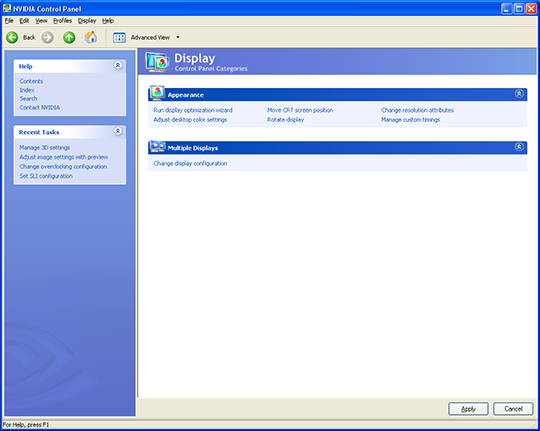 |
| Click to enlarge |
Under the display menu, we see a section for appearance, and multiple displays.
Display Optimization Wizard
This item offers a wizard to help you optimize your display. The following nine screenshots show the steps of the wizard, though the flat panel display calibration step is skipped for non-flat panel displays. (We would recommend choosing flat panel regardless, if you want to use the test pattern to try and align the image on a CRT display.)
 |
 |
 |
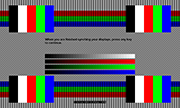 |
 |
 |
 |
 |
 |
| Click to enlarge | ||
First you get the introduction, followed by your display(s). If you choose one of the displays as being a flat panel, you get an extra two screens for flat panel optimization. Next is a screen for color temperature. We found this screen to be a little confusing, but basically what it's saying is that you should use the controls of your display to set the temperature to what you find appropriate. That's not particularly helpful, and the text could be better at explaining what you're supposed to do. Telling you to "set the color temperature to the value that most accurately represents white" when the majority of the screen is black is also less than useful.
After another helpful preparation screen, you get to optimize the brightness and gamma levels of your display. It should be noted that 100% contrast setting is not always ideal on every display. The gamma correction page is also a bit confusing, as the boxes don't actually slide left/right; instead, you click and drag and the color bars change while your mouse cursor moves and the white box remains in the center of the display. The end result of the display optimization wizard is that some people will get slightly better colors for their display, but it's not the same as professional color calibration tools. Still, it's better than nothing.
Move CRT Screen Position
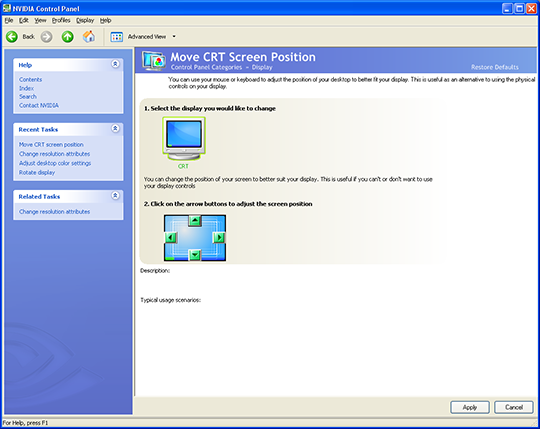 |
| Click to enlarge |
Change Resolution Attributes
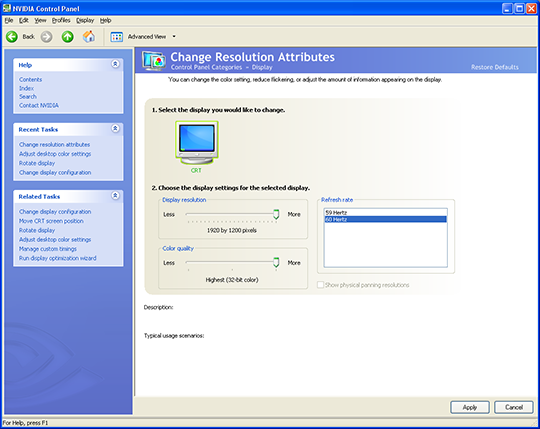 |
| Click to enlarge |
Here we see a simple menu to change screen resolution and color quality, as well as the refresh rate.
Adjust Desktop Color Settings
 |
| Click to enlarge |
This section gives you control over several color settings to fine tune your display image.
Rotate Display
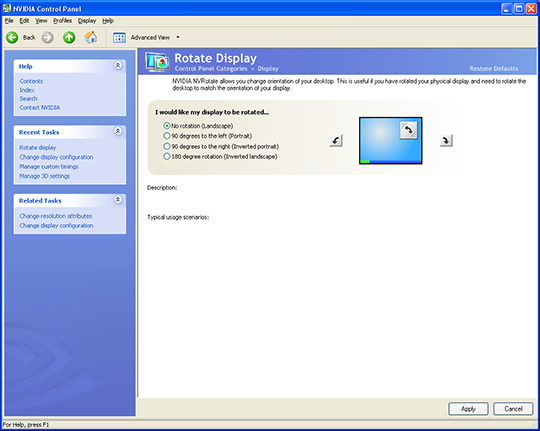 |
| Click to enlarge |
Change Display Configuration
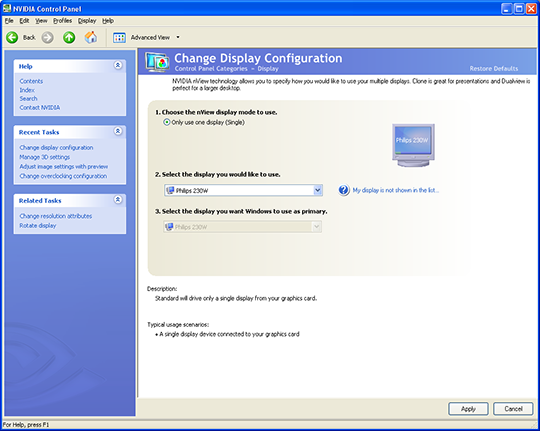 |
| Click to enlarge |
This section is a straightforward menu that allows you to configure your display configuration if you use multiple displays. Similar functionality is present in the standard Windows Display dialog, so this is basically redundant.
Manage Custom Timings
 |
| Click to enlarge |
Having become accustomed to the custom resolution options with the previous control panel, the new version doesn't seem to have all of the same features. For example, in the old NVIDIA interface, there was an easy-to-use dialog that allowed customization of HDTV output signals, including a section for overscan correction, a.k.a. underscan. That appears to be completely missing from the new control panel, though this may be more a case of their Beta nature than a conscious decision on NVIDIA's part. Here are some images showing the new interface as well as the missing overscan correction UI.
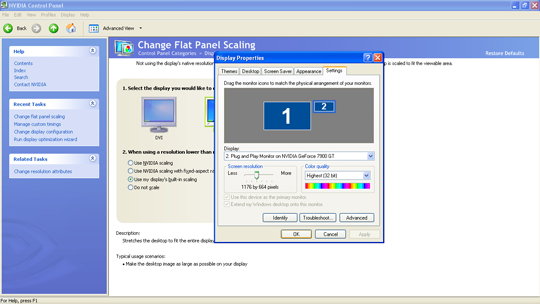 |
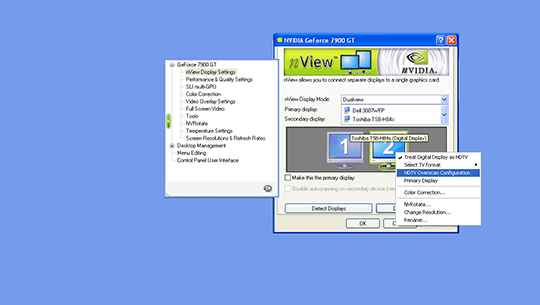 |
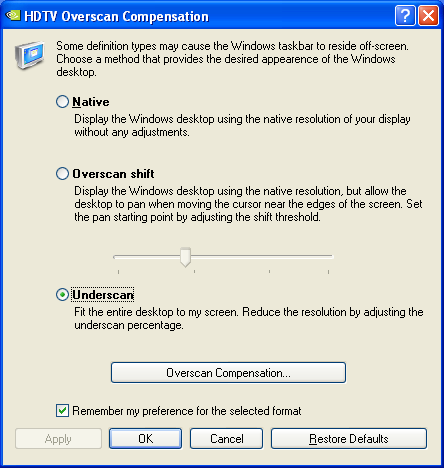 |
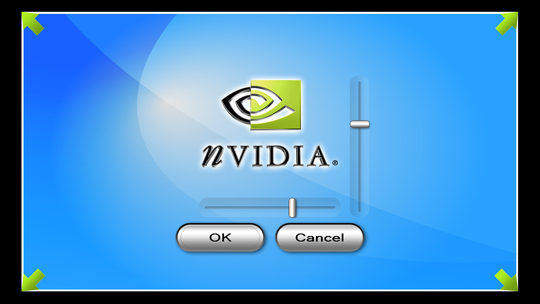 |
| Click to enlarge |
What's worse is that the custom resolutions simply don't seem to work properly with the new UI. You can see the first screen which used the new UI to create a custom resolution of 1176x664. Everything seems to be in order, but then why is the screenshot still 1280x720? Try as we might, we could not get the customized 720p underscan resolution to work with the new UI. Switching back to the old interface remedies the problem in short order. (The black border on the last image represents the area on a Toshiba 46H84 HDTV that isn't visible, in case you were wondering.)
Video and Television Settings
 |
| Click to enlarge |
 |
 |
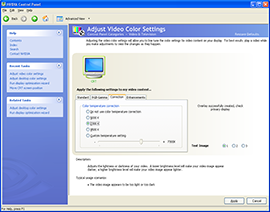 |
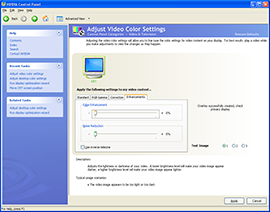 |
| Click to enlarge | |
The third menu selection only has one option available in it, adjust video color settings. This basically offers the same color settings that we saw for the display color settings, only for video content. Video overlay mode takes a different route through the drivers, and this allows you to tune your color output separately. This functionality has been present in both ATI and NVIDIA drivers for quite some time, of course.










24 Comments
View All Comments
unclebud - Monday, June 26, 2006 - link
i can see thatreadily evident from the cookie cutter response i was given in return --
must work in tech support to just ignore my problem and post a completely unusable solution like that. hmh
i said ati doesn't make me install ANYTHING BUT THE DISPLAY DRIVER, unlike NVIDIA
it didn't work either, the dvi port is still unrecognized by NVIDIA'S "DRIVERS". playing gta is even more choppy. thanks for nothing... :( i should have known better than to ask for help in here
mindless1 - Saturday, June 10, 2006 - link
I prefer the current/old CP UI too. Let's hope someone hacks it so the old CP can be used with the new drivers.DerekWilson - Sunday, June 11, 2006 - link
if it wasn't clear in the article, the old version can still be used, but is not by default.if nv follows ati, we won't have to worry about them ditching the old cp for a good while... but it still going to be a pain to switch back after every install.
amdwilliam1985 - Saturday, June 10, 2006 - link
does anyone knows the performance of the new series of drivers? i still cannot find a good driver that could beat my 77.77, btw i'm running 6600gt. i have tried some 80th series drivers, but they all gave me lower 3d05 and 06 scores. someone want to recommend a best driver for my 6600gt?JarredWalton - Saturday, June 10, 2006 - link
A lot of the driver updates address specific issues in specific games, so often there's not much point in upgrading. Of course, basing your decision on whether or not the drivers are better off of 3DMark is not generally a good way to go, unless you play 3DMark on a regular basis. You might want to look at our http://www.anandtech.com/video/showdoc.aspx?i=2754">NVIDIA Regression Testing article for some more information on which drivers to use. Basically, if you haven't encountered problems with any games using the 77.77 drivers (lucky number seven?), you might as well stick with them until you do.unclebud - Friday, June 9, 2006 - link
today i just bought a stupid bfg fuzion 6200 pci card and am having trouble just getting the bloatware that is nvidia installed!!! i don't need a stupid 21 mb ui running in the tray to play a game!!!i bought some x1600 pros from sapphire - windows xp asks for drivers - insert disc - boom! drivers installed... done
windows xp found drivers for pny 5200/5500 pci AUTOMATICALLY, with NO need for a disc. done
but now, eveyrtime i try to install the drivers that were downloaded from their buggy site -- or off of the disc, it wants to connect to the internet for "updated version" or some baloney
blah nvidia... 3dfx must be turning over in their grave...
JarredWalton - Saturday, June 10, 2006 - link
I have no idea what difficulties you're having, but it's pretty simple on NVIDIA cards: skip the Windows "new hardware" dialog, run the NVIDIA install, reboot and you're done. If that's not working, then most likely it's due to driver conflicts with whatever card you were using before. Try Driver Cleaner to fix that sort of thing.According to a couple test systems I have in front of me:
-----------------------
NVIDIA 6800 GS SLI config:
Athlon 64 3800+ 939
2x512MB RAM
nvsvc32.exe: 3300KB
(Yes, I'm sure there is more memory used elsewhere that doesn't show up in task manager.)
Right-click on desktop and select NVIDIA Control Panel, and it takes 3 seconds for the CP to appear.
ATI X1600 Pro:
Opteron 146 @ 2.8 GHz
2x512MB RAM
ati2evxx.exe: 2132KB
ati2evxx.exe: 2860KB
CLI.exe: 5088KB
CLI.exe: 8512KB
(The above comment also applies here: there is more memory used by the ATI drivers than is indicated in task manager. If not, what's happening that takes so long in the following test?)
Right-click desktop and select ATI Catalyst Control Center; wait 11 seconds for it to appear, watch the screen flicker, and then once loaded the various pages still take a lot longer to display.
Bottom line is that I find the ATI drivers to be far less responsive, they use more memory (hello .NET!), and of course the older NVIDIA control panel is still my preferred solution.
DerekWilson - Friday, June 9, 2006 - link
This incarnation of NVIDIA's control panel places a cartoonish mask over a clunky and hard to use interface.If they were going for vista, they need to actually make it work like vista and not stop short at oversized icons. It's like they took the least useful part of vista and decided to grab on for dear life.
This UI can be saved, but they need to go back to having fewer menus within menus (or at least bring some frequently used options closer to the top level). There are just too many clicks involved to get to the real options. And saving recent tasks is good, but its just not good enough.
It's not even about saving time for those of us who need to navigate these settings all day every day (though that's a factor as well) -- its all about ease of use and intuitive design. This new control panel has neither.
of course, that's all in my opinion :-)
Athlex - Friday, June 9, 2006 - link
Exactly. Microsoft did the same thing to the Win2K interface when they cranked out XP. I think I lucked out by sticking with Windows 2000. Just installed a 7800GS and 90-series drivers in my machine and it appears to have the older-style control panel like the 80-series drivers.One43637 - Friday, June 9, 2006 - link
looks tacky to me. doesn't it seem like they just embedded the control panel into a MS window?/shrugs